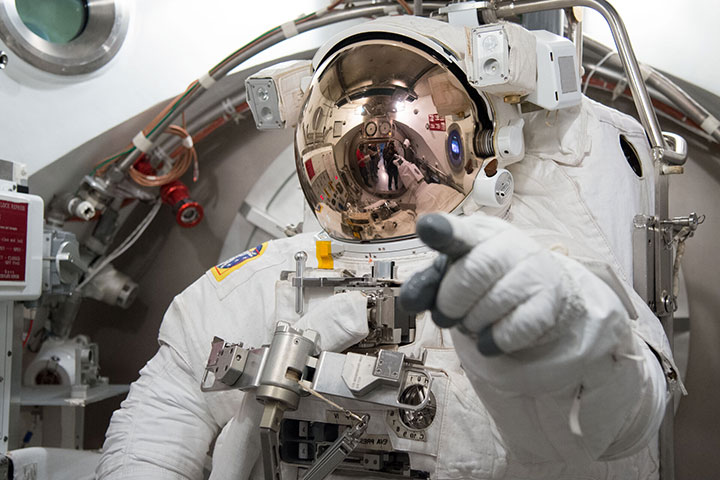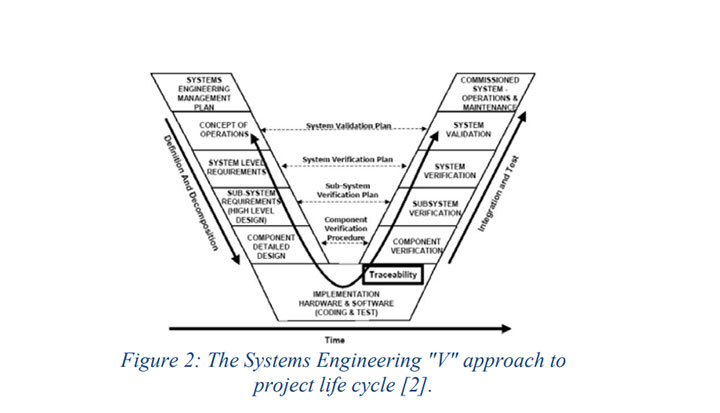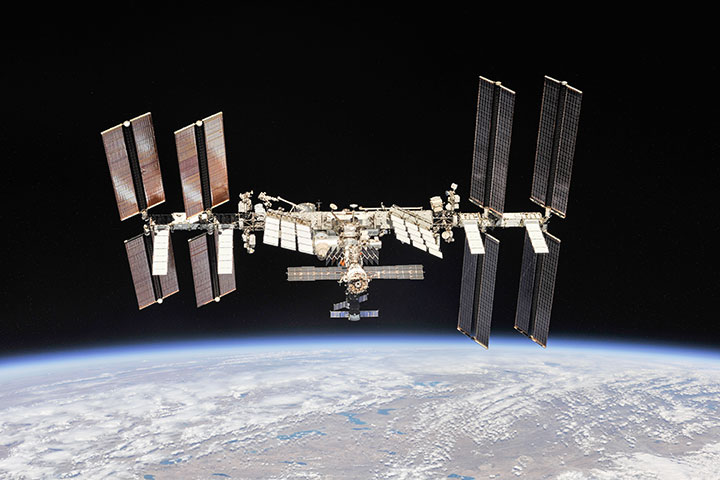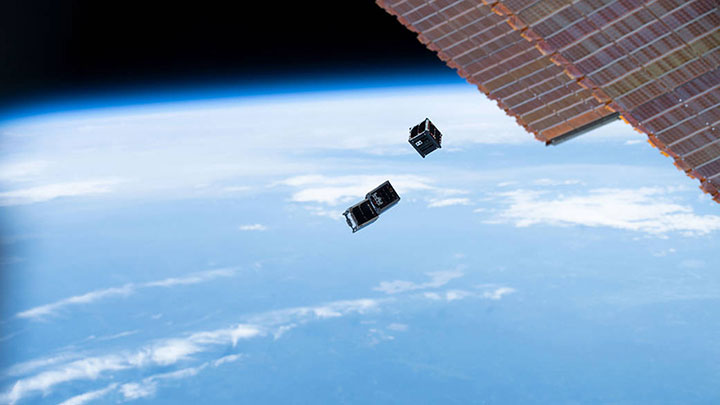ALEXANDRIA, Va. — Space is no longer an exclusive club. The number of space-capable nations has grown exponentially in recent years. Australia, Bahrain, Costa Rica, Egypt, Greece, Kenya, Luxembourg, New Zealand, North Korea, Paraguay, the Philippines, Portugal, Saudi Arabia, Syria, Turkey, the UAE and Zimbabwe established their own national space agencies within the last decade.
More advanced space actors, like France, the United Kingdom and United States have updated their strategies to account for the increased importance of cutting-edge technologies, commercial players and space as a warfighting domain. While growing space actors like India, Japan, Turkey and Vietnam have unveiled multi-year plans to promote space science, industry and development.
 Dan Erkel, a PhD candidate at MIT’s Engineering Systems Laboratory, developed a systems engineering approach to space strategies for emerging actors. (Source: Daniel Erkel)
Dan Erkel, a PhD candidate at MIT’s Engineering Systems Laboratory, developed a systems engineering approach to space strategies for emerging actors. (Source: Daniel Erkel)
In 2021, the Hungarian government approved a new national space strategy focused on furthering Hungary’s contributions to the global space value chain, driving innovation, economic growth and the social and economic infrastructure base needed to compete successfully in the field of space. Part of that included sending a Hungarian astronaut to space by 2025.
Dan Erkel, a dual British-Hungarian citizen with a background in space systems engineering, was brought into that process in 2020 as the lead technical expert in developing Hungary’s strategy. He also came close to representing Hungary as an astronaut, making it to the European Space Agency’s penultimate selection round in 2022.
Erkel’s experience developing Hungary’s national space strategy helped inspire his pursuit of a PhD in Aeronautics and Astronautics and a Master of Science in Technology and Policy at MIT’s Engineering Systems Lab, where he currently studies under Olivier de Weck, Apollo Program Professor of Astronautics.
“I quickly realized, there was no such thing as a blueprint for space strategies,” Erkel told Constellations. “There are a lot of books on strategy but nothing really on architecting successful space strategies. A lot of countries are joining this industry right now and there is no guidance on how to do this.”
Accounting for Complexity
Earlier research by MIT’s Danielle Wood and Annalisa Weigel documented the “space technology ladder,” charting the path followed by emerging space actors in Asia, Africa and Latin America. The path typically starts with the creation of a national space agency, then owning and operating a LEO satellite, then a GEO satellite and finally, establishing launch capability.
 Recent years have seen a growing number of emerging actors establish space programs for prestige, national security and the societal benefits associated with space technologies. (Source: ESA)
Recent years have seen a growing number of emerging actors establish space programs for prestige, national security and the societal benefits associated with space technologies. (Source: ESA)
While a useful description, Erkel found there were still no clear methods for emerging actors to develop a successful space strategy. To fill the gap, Erkel adopted a systems engineering approach to account for the human and technological complexities new actors face in the high-risk, fast-evolving field of space.
“There’s an adage we refer to in systems engineering as Conway’s Law, that essentially says the final product of an organization will reflect the organization’s complexity and communication structure,” Erkel explained. “Certainly, for space organizations and space strategies, their structure has to reflect the complexity of the space systems and spacecraft, and the environment in which they operate—both the international, earthbound context where you create these architectures and also the operating environment of space, which is the harshest environment you have.”
Erkel writes in his thesis, “The Success of Emerging Space Actors: Effective Strategies in the NewSpace Era,” that a national strategy should be viewed as a space system, where specific programs and investments are viewed as subsystems, involving stakeholders, requirements definitions, integration, validation and other elements found in a traditional V-model.
 The V-model in systems engineering shows the timing and interaction of life cycle activities, including requirements development and management. (Source: NASA)
The V-model in systems engineering shows the timing and interaction of life cycle activities, including requirements development and management. (Source: NASA)
Rather than the sum of the programs adopted, the strategy becomes a “system of systems problem,” where each program, such as a national communications satellite or an astronaut program, is a “strategic system” with requirements (technical, social, economic, etc.) as well as a function, form and emergent system behavior that interacts with other programs.
To evaluate whether these strategy architectures are ultimately successful, Erkel introduced the concept of portfolio optimization, commonly used in finance. In this case, each program is viewed as an investment and the strategy is the portfolio.
“This is, in fact, often done in the defense domain but has not yet been implemented in the context of developing space strategies,” he said. “The main difficulty is estimating the yield of investments when the primary outcome is a public good, such as national security, prestige, or socio-technical development.”
Erkel also outlined an agile engineering method he called Digital, Agile, Concurrent and Redundancy-based Engineering (DACRE), which builds on lessons learned in the commercial space industry to address budgetary, technology and schedule constraints faced by emerging space actors. The approach aims at descoping and de-risking through the simultaneous development of a primary, simpler mission concept and a secondary more complex one, designing interfaces that allow for rapid pivoting from one to the other.
It is difficult if not impossible to change the scope of a space project after it has started without adding to cost and schedule. But an iterative and flexible program design can adapt to changes in resources or circumstances with the option to fall back on a primary mission design that meets basic user needs.
Relying on modularity, computer-aided design and testing, short lead times, supply chain redundancy and the use of miniaturized and commercial off-the-shelf (COTS) components, Erkel argued the DACRE approach minimizes the risk of mission failure, cost overruns and delays. His proof was a $10,000 microgravity experiment conducted with a team of MIT engineers.
With a small budget and the DACRE approach, the MIT team was able to develop, deploy and test a satellite refueling mission, Ouroboros, in partnership with Blue Origin’s New Shepard Mission NS-17.
Advantages of Technology Transfer
Microgravity experiments, like the Ouroboros, are an example of a promising inroad for emerging space actors to build capacity and make novel contributions to the field of space, according to research. For decades, emerging nations, researchers and private companies have made fundamental breakthroughs in science and technology with minimal cost and risk by partnering with more advanced space actors. Such technology transfer programs are exemplified by the International Space Station, ESA, NASA and the Artemis Accords, which have enabled emerging actors to participate in and benefit from high-level space activities.
“The beauty of space technology is that it involves so many different scientific areas. You’re simultaneously building capabilities in the space domain itself as well as in segments which provide the so-called enabling technologies … which is what makes space uniquely well-suited for technology transfer,” Erkel said.
 More than 200 people from 15 countries have spent time aboard the International Space Station, which offers a microgravity environment for experimentation. (Source: NASA)
More than 200 people from 15 countries have spent time aboard the International Space Station, which offers a microgravity environment for experimentation. (Source: NASA)
The complexity of space and demand for subsystems offer opportunities for emerging actors to make novel contributions, which is not necessarily the case in other high-tech industries. “The space industry still has niche markets where you can potentially be a first mover or an early responder,” he added. Innovations fostered through technology transfer have strong benefits for both the emerging actor and the broader space community.
In addition to establishing a national space presence, technology transfer supports the development of sovereign engineering capabilities in direct and adjacent industries. Erkel saw this firsthand as the lead payload thermal engineer on AngoSat2, the Angolan communications satellite built in collaboration with Airbus and Roscosmos. He did similar work in collaboration with Turkish engineers on Turksat 5a, a geostationary satellite used for military and commercial communications.
Nations that set their eyes on space always have an end goal in mind, whether it’s national prestige, security or harnessing the proven societal and economic benefits associated with space technology. There is no cookie-cutter approach that will guarantee an emerging actor meets their goal successfully. But that does not mean that resource-constrained nations should avoid engaging in space activities, Erkel insisted. If anything, it underscores the importance of a space strategy architected as a system of systems and built on concepts of agile engineering and technology transfer to mitigate cost and schedule issues, while increasing potential benefits to society.
The ‘Illusion of Simplicity’ in NewSpace
As of January 2023, over 80 countries had a registered satellite in orbit and 11 countries had demonstrated independent launch capabilities. Universities and research labs have successfully deployed smallsats and companies built in garages now have dozens of spacecraft in orbit.
The drop in satellite launch and manufacturing costs, as well as the miniaturization of electronics and availability of COTS components, has made space more accessible. The OECD noted in a report, “[T]he possibility to have one’s own satellite in orbit, registered with one’s own national administration, has never been so affordable.”
 Three university CubeSats are deployed from the International Space Station on July 3, 2019. Affordable launch and other factors have made space more accessible but it remains risky. (Source: NASA)
Three university CubeSats are deployed from the International Space Station on July 3, 2019. Affordable launch and other factors have made space more accessible but it remains risky. (Source: NASA)
Moreover, governments are no longer the sole investors in space. In the last 10 years, investors have poured $273.3 billion of private equity into space companies and startups—accompanied by heightened expectations returns.
While these changes have increased opportunities for emerging actors to reap the benefits of space, success is not guaranteed.
“Emerging actors in the space sector is not a new phenomenon—take the example of Malaysia or South Korea, nations which have been active in the domain since the 80s or 90s,” Erkel explained. “What is different today in the NewSpace era, is that some of the really appealing technologies come across as cheap, fast, effective, and above all, potentially highly profitable… But it doesn’t mean it’s not risky.”
A demonstration satellite can cost less than $100,000 and be built in a few years. But it may not generate returns financially, scientifically, technologically or for the common good. Larger, more complex programs can take decades and carry high capital expenditures and cost overruns. The space market has also proven to be volatile for new actors, particularly over the last year, with unsettled questions about long-term profitability and market demand.
There is also an emerging “tragedy of the orbital commons” situation where more advanced space actors utilize valuable low Earth orbits and frequencies, leaving fewer options for late entrants. Companies and organizations have announced plans for as many as 100,000 satellites in the next decade. Currently, more than half of the satellites deployed in LEO belong to the Starlink or OneWeb constellations. Space is vast, but even with orbital slotting there are concerns about carrying capacity, after which the risks of conjunction, congestion and interference increase significantly.
Without evaluating this complex backdrop, the successes of the NewSpace era have created “an illusion of relative simplicity” for new actors, that can make it more difficult to parse the risks, Erkel noted.
As space takes an increasingly important role in the functioning of terrestrial society, nations will face the choice of entering the domain or being left behind. Moves by satellite operators to occupy orbital slots and allocations of finite bandwidth highlight the urgency.
In the coming years, Erkel hopes emerging nations “can join the ranks of the most advanced space powers and like them, deploy satellite constellations that serve security, commercial, market and societal needs or take part in human spaceflight, providing them full access to space and its socio-economic benefits in an equitable way with a fair allocation of costs and benefits.”
Explore More:
University Spotlight: How an Experimental GPS Receiver Is Changing Electronic Warfare
University Spotlight: Enabling SmallSat Autonomy Through Onboard Fault Detection
Podcast: Future of Satellite Connectivity and Other Key 2023 Space Trends
